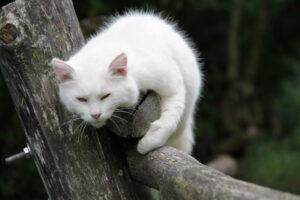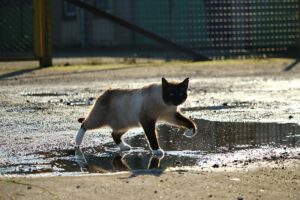How High Can A Cat Jump ?

How High Can A Cat Jump :- Cats are renowned for their remarkable athletic abilities, evident in their agile and acrobatic movements. If you’ve ever witnessed your cat swiftly navigating your home, effortlessly leaping from the back of the couch to the top of the refrigerator in a mere 5 seconds, you’re familiar with their impressive skills.
Official entities, such as Guinness World Records, have recognized and celebrated feline athleticism. In 2018, Waffle the Warrior Cat secured the world record for the longest jump by a cat with an astounding 7-foot horizontal leap!
However, a cat’s physical prowess is not merely a flashy party trick. Cats are natural hunters, and many of their physical traits are finely tuned for efficient prey capture. These same features also serve to protect cats from potential injuries, even in scenarios like falling from a considerable height, as demonstrated by a cat surviving a 32-story fall in New York City.
While cats exhibit numerous impressive feats, today’s focus is on their vertical jumps. Spoiler alert: Cats can leap to impressive heights, showcasing their extraordinary athleticism.
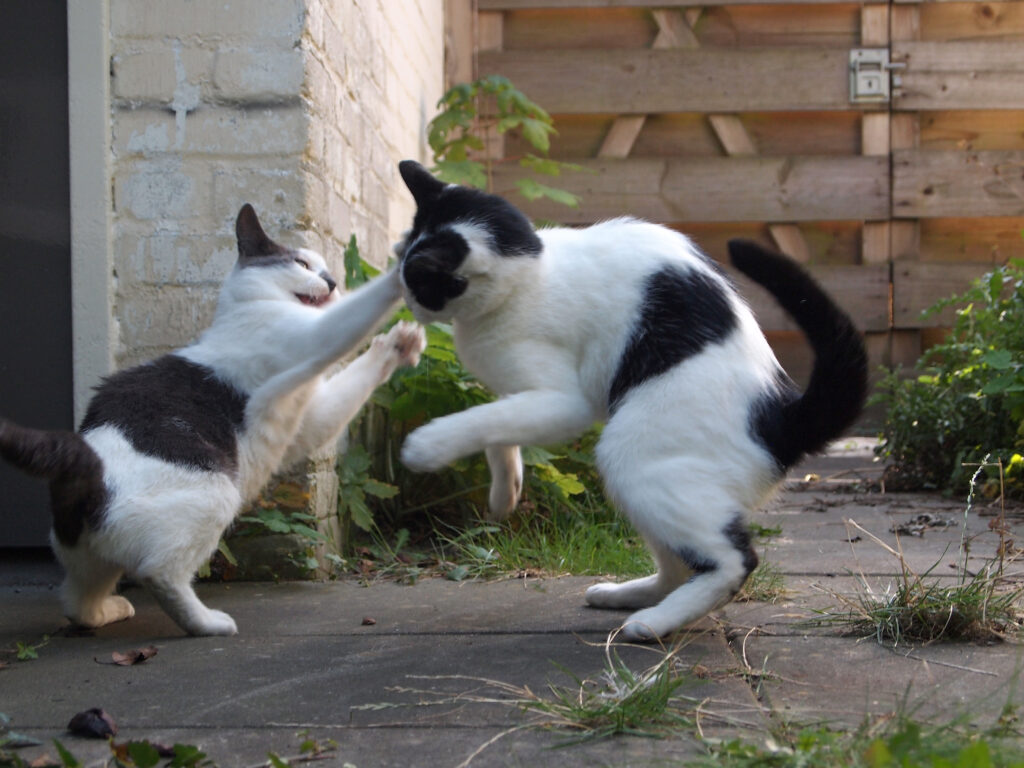
How High Can Kittens Jump?
Kittens, in their early stages of development, aren’t capable of jumping as high as adult cats. This limitation arises from the ongoing process of building strength and refining balance. As they grow, kittens start to attempt vertical or distance jumps and may have many misses before gaining enough strength, balance, and good judgment of distances.
The expert emphasizes the importance of providing kittens with opportunities to practice jumping. This practice is not just a playful activity; it plays a crucial role in shaping their future abilities. Cats that lack these opportunities during their kittenhood are more likely to face limitations in their jumping prowess as adults. Encouraging and facilitating these playful exercises contributes to the development of a cat’s physical skills, ensuring their agility and mobility in adulthood.
How High Can A Cat Jump ? How Cats Jump So Well
The ancestral roots of all domesticated cats can be traced back to the North African/Near Eastern wildcat, a species adept at dwelling in trees.
These wildcats needed to be able to swiftly jump to high perches for safety, observation, and rest. They also needed the ability to jump, twist, and turn—both to pursue prey and to evade predators.” The domestic cats of today have preserved many of the same anatomical features of their wildcat ancestors. The physiological adaptations of modern domestic cats are finely tuned to make them adept leapers:
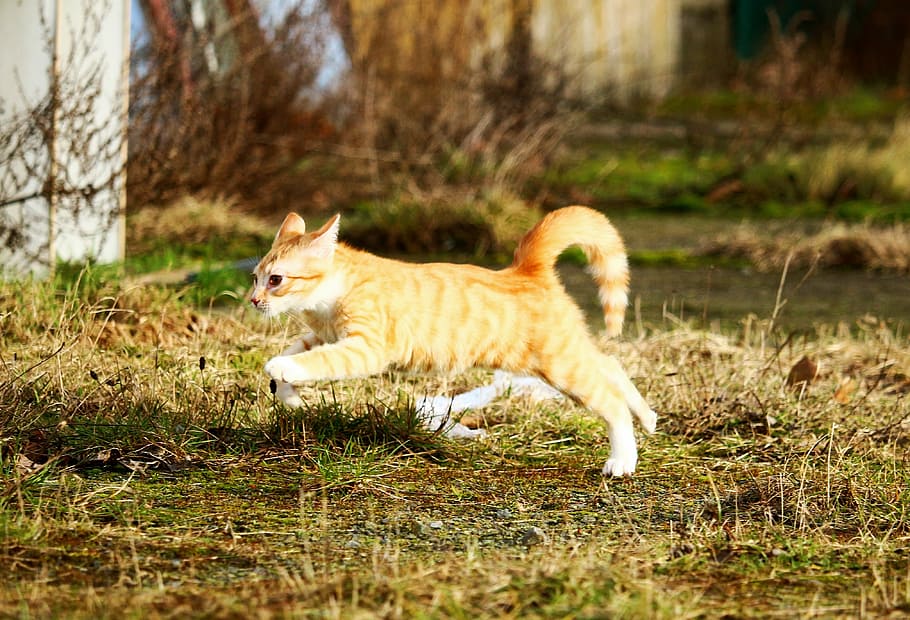
- Muscular System:- Cats exhibit an impressive array of over 500 muscles, utilizing each one when executing leaps.
- Hind Legs:- Supported by robust and elongated hind legs, cats possess “fast twitch” muscle fibers facilitating bursts of movement. The angulation of their back legs contributes to effective shock absorption upon landing.
- Paw Cushions:- The paw cushions are equipped with numerous nerve receptors, aiding cats in evaluating optimal surfaces for jumping and enhancing overall balance. Cats leverage their tails for additional balance.
- Front Legs and Claws:– Cats instinctively extend their front legs towards their destination as their back legs propel them forward, ensuring stability. Claws play a vital role in grasping landing surfaces, adding an extra layer of stability.
- Bone Structure:– Cats boast a remarkable bone structure, comprising over 200 bones, including up to 23 in their tail and 30 in their spine. The flexibility of their spine, coupled with the ability to arch, allows cats to make mid-air course corrections, known as the “righting reflex.”
- Whiskers:- Whiskers are instrumental, with proprioceptive follicle cells enabling cats to sense their body’s position, location, and orientation in relation to the ground. Whiskers also detect subtle vibrations and air currents, protect their eyes and faces, and assist in judging distances—critical elements for the precision of the jumping process.
In essence, the exceptional jumping abilities of cats stand as a testament to the evolutionary refinement of their anatomy, a legacy inherited from their tree-dwelling ancestors.
How High Can A Cat Jump ? Comparison of Cat Jump Heights
This comparative table illustrates the jumping heights of various cat species, listed from the greatest to the lowest leaping ability. Living in snow leopard territory might warrant keeping second-story windows closed, as they can effortlessly clear such heights. While the black-footed cat’s 5-foot jump might seem modest, it surpasses the average person’s jump of 1.5-2 feet. Even the best NBA players, with a limit of around 3.75 feet (45 inches), fall short of the world’s smallest cat’s jumping prowess. To put it in perspective, if a 4-pound cat can jump 5 feet, a 100-pound human, with equivalent muscle performance, should theoretically be able to leap 125 feet—equivalent to the height of a 12-story building! A playful reminder for humans: never skip leg day!
| Species | Weight | Vertical Jump |
| Snow leopard | 72 lbs. | 20 ft. |
| Tiger | 680 lbs. | 20 ft. |
| Cougar | 220 lbs. | 18 ft. |
| Serval | 26 lbs. | 15 ft. |
| Lion | 420 lbs. | 12 ft. |
| Bobcat | 40 lbs. | 10 ft. |
| Jaguar | 210 lbs. | 10 ft. |
| Domestic cat | 11 lbs. | 7 ft. |
| Jaguarundi | 15 lbs. | 6 ft. |
| Black-footed cat | 4 lbs. | 5 ft. |
Making Sure Your Cat Jumps Safely
While it might be tempting to let your kitty use your home as a jungle gym, there are potential risks to consider. Cats, being unaware of when stoves or other heated appliances are on or off, could inadvertently get burned if allowed to leap onto counters near these areas.
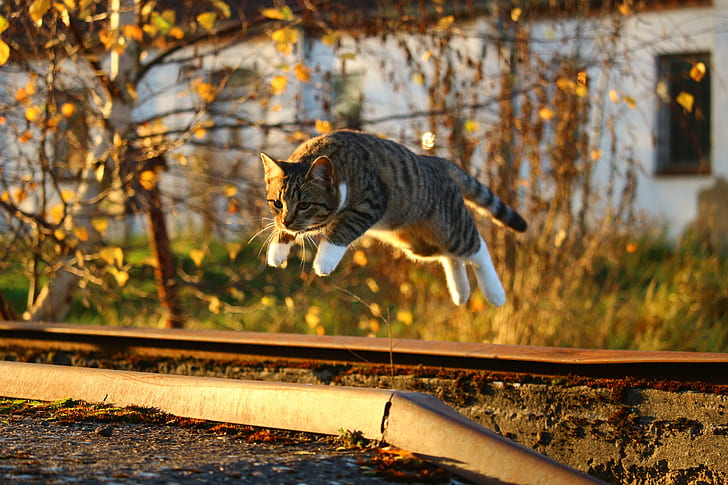
To address these varying needs, she ensures the presence of cat trees in safe locations and a catio that offers stability and access to different height levels. Additionally, supportive props like pet stairs are provided to assist her older cat in reaching higher areas and descending in ways that are gentler on his joints.
For those keen on setting boundaries, suggests positive reinforcement clicker training. By employing this technique, you can teach your cat to recognize suitable high spots while discouraging leaps and bounds in restricted areas. This approach not only enhances safety but also promotes a positive and interactive relationship with your feline companion.

